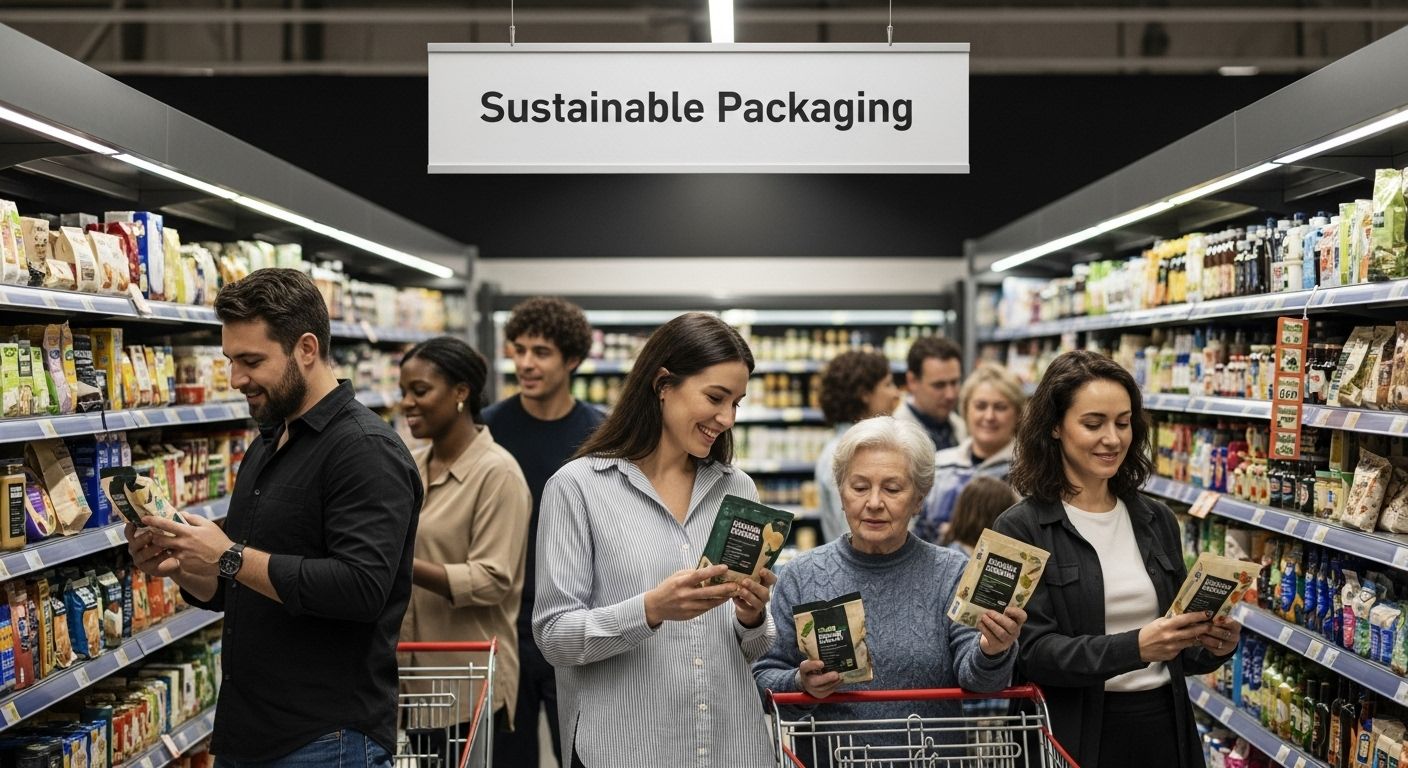
Sustainable packaging is getting a lot of attention, with companies and shoppers both pushing for greener choices. Plastic packaging alone accounts for millions of tons of waste dumped into our environment every year. You might expect that switching to recycled materials is enough to solve all these problems. But sustainable packaging actually means rethinking everything from how packages are designed to what happens after you toss them, and it is changing what business and responsibility really look like.
Table of Contents
- Defining Sustainable Packaging: What Is It And Why It Matters?
- Environmental Impact: The Importance Of Sustainable Packaging
- Materials And Innovations: How Sustainable Packaging Works
- Consumer Choices And Trends: The Rise Of Sustainable Packaging
- Challenges And Future Perspectives: Navigating Sustainable Solutions
Quick Summary
| Takeaway | Explanation |
|---|---|
| Sustainable packaging reduces environmental impact. | It minimizes waste and conserves resources throughout the product lifecycle, promoting ecological responsibility. |
| Consumer demand drives sustainable practices. | Brands adopting sustainable packaging attract eco-conscious customers, enhancing loyalty and market competitiveness. |
| Innovative materials are key to sustainability. | Using advanced biomaterials and recyclable options helps to lower the ecological footprint of packaging. |
| Systemic challenges hinder widespread adoption. | Economic costs and technological barriers impede the transition to sustainable packaging, requiring collaborative efforts to overcome. |
| Smart packaging enhances product lifecycle. | Interactive packaging technologies monitor freshness and improve waste management by making packaging more functional and responsible. |
Defining Sustainable Packaging: What Is It and Why It Matters?
Sustainable packaging represents a transformative approach to material design, production, and disposal that prioritizes environmental responsibility and minimizes ecological impact. At its core, sustainable packaging seeks to balance functional product protection with reduced environmental footprint across the entire product lifecycle.
Understanding the Core Concept
Sustainable packaging goes far beyond simply using recyclable materials. It encompasses a holistic strategy that considers resource extraction, manufacturing processes, transportation efficiency, product use, and end-of-life disposal. The United Nations Environment Programme defines sustainable packaging as solutions that minimize resource consumption, limit lifecycle environmental impacts, and support circular economy principles.
Key characteristics of sustainable packaging include:
- Using renewable or recycled materials
- Designing for minimal waste generation
- Reducing carbon emissions during production
- Enabling easy recycling or composting
- Minimizing overall environmental burden
Environmental and Economic Implications
The global shift towards sustainable packaging is driven by urgent environmental challenges and increasing consumer awareness. According to United Nations Environment Programme, traditional packaging contributes significantly to global waste streams, with millions of tons of plastic entering ecosystems annually.

Businesses adopting sustainable packaging strategies not only reduce environmental impact but also gain competitive advantages. Consumers increasingly prefer brands demonstrating genuine commitment to ecological responsibility. This trend translates into tangible market benefits, including enhanced brand reputation, customer loyalty, and potential cost savings through more efficient material use.
Sustainable packaging represents more than a trend—it’s a critical evolution in how we conceive product design, consumption, and environmental stewardship. By reimagining packaging as a dynamic, responsible system, we can dramatically reduce waste and create more regenerative approaches to product delivery and consumption.
Environmental Impact: The Importance of Sustainable Packaging
The environmental consequences of traditional packaging are profound and far-reaching, creating substantial challenges for global ecosystems, climate stability, and human health. Packaging waste represents a critical environmental crisis that demands immediate and comprehensive action across industries and consumer practices.
Ecological Consequences of Traditional Packaging
Traditional packaging materials, particularly single-use plastics, generate massive environmental burdens. The production and disposal of these materials contribute significantly to greenhouse gas emissions, resource depletion, and ecosystem degradation. Plastic packaging alone accounts for millions of tons of waste annually, with devastating impacts on marine environments, terrestrial ecosystems, and wildlife habitats.
Key environmental challenges include:
- Persistent microplastic pollution in oceans and waterways
- Long-term environmental contamination from non-biodegradable materials
- Significant carbon emissions during packaging production
- Destruction of natural habitats through resource extraction
- Overwhelming waste management infrastructure
Global Waste and Climate Implications
According to the Organisation for Economic Co-operation and Development, packaging waste represents a critical environmental challenge with far-reaching consequences. The global packaging industry generates approximately 141 million tons of plastic packaging waste annually, with less than 10% effectively recycled.
The environmental impact extends beyond waste volume. Packaging production and disposal contribute approximately 3-4% of global greenhouse gas emissions, creating a substantial carbon footprint. Each stage of packaging lifecycle generates environmental stress, from raw material extraction to manufacturing, transportation, and eventual disposal.
Sustainable packaging emerges as a critical solution to these complex environmental challenges. By reimagining packaging design, materials, and lifecycle management, industries can significantly reduce ecological damage, conserve natural resources, and create more regenerative systems that support planetary health and long-term sustainability.
Materials and Innovations: How Sustainable Packaging Works
Sustainable packaging represents a complex ecosystem of innovative materials, advanced technologies, and strategic design principles that fundamentally reimagine product protection and environmental responsibility. By integrating cutting-edge scientific research with ecological considerations, sustainable packaging solutions are transforming traditional manufacturing approaches.
To clarify the different material options discussed in the sustainable packaging section, the following table categorizes emerging technologies and their source materials.
| Material Technology | Source Material | Key Environmental Benefit |
|---|---|---|
| Bioplastics | Plant-based sources | Renewable, reduces reliance on fossil fuels |
| Cellulose-based packaging | Agricultural waste | Biodegradable, utilizes waste resources |
| Mycelium materials | Fungal networks | Compostable, grows with low energy input |
| Seaweed and algae-based films | Marine plants | Fast-growing, biodegradable |
| Recycled/upcycled composites | Post-consumer/use waste | Diverts waste, reduces raw resource demand |
Emerging Material Technologies
The foundation of sustainable packaging lies in developing advanced biomaterials that offer performance comparable to traditional plastics while minimizing environmental impact. These next-generation materials leverage renewable resources, biodegradability, and advanced chemical engineering to create packaging solutions that are both functional and environmentally conscious.
Key innovative material categories include:
- Bioplastics derived from plant-based sources
- Cellulose-based packaging from agricultural waste
- Mycelium materials grown from fungal networks
- Seaweed and algae-based packaging films
- Recycled and upcycled composite materials
Smart Packaging Innovations
Recent technological advancements are pushing sustainable packaging beyond traditional material considerations. According to research published in advanced materials science, emerging packaging technologies now incorporate intelligent monitoring systems that can track food freshness, release preservation compounds, and provide real-time environmental data.
These innovations extend product lifecycle, reduce food waste, and create more responsive packaging systems. Smart packaging technologies integrate sensors, biodegradable electronics, and active preservation mechanisms that transform packaging from a mere container into an intelligent, interactive system.
Sustainable packaging represents a profound technological and philosophical shift. By reimagining packaging as a dynamic, responsive, and regenerative system, researchers and designers are creating solutions that not only minimize environmental harm but actively contribute to ecosystem health and resource conservation.
Consumer Choices and Trends: The Rise of Sustainable Packaging
Consumer awareness has become a powerful catalyst in driving sustainable packaging transformation, fundamentally reshaping how businesses approach product design, marketing, and environmental responsibility. As environmental consciousness grows, individuals are increasingly making purchasing decisions that reflect their commitment to ecological sustainability.
Shifting Consumer Preferences
Modern consumers are no longer passively accepting packaging practices. Younger generations, particularly millennials and Gen Z, are leading a significant market shift by demanding transparent, environmentally responsible packaging solutions. Their purchasing behaviors demonstrate a willingness to pay premium prices for products that align with sustainable values and showcase genuine environmental commitment.
The following table summarizes key consumer motivations driving the shift to sustainable packaging, providing a quick reference for understanding market trends discussed in the article.
| Consumer Motivation | Description |
|---|---|
| Reducing environmental footprint | Selects products to lower personal impact |
| Supporting transparent brands | Prefers companies with clear ecological practices |
| Minimizing plastic waste | Chooses packaging with less single-use plastic |
| Encouraging corporate accountability | Seeks companies responsible for sustainability |
| Promoting circular economy principles | Favors reusable, recyclable, and compostable options |
Key consumer motivations include:
- Reducing personal environmental footprint
- Supporting brands with transparent ecological practices
- Minimizing plastic waste generation
- Encouraging corporate environmental accountability
- Promoting circular economy principles
Market Dynamics and Business Response
According to the Organisation for Economic Co-operation and Development, global consumer preferences are increasingly driving corporate packaging strategies. Businesses recognize that sustainable packaging is no longer a niche marketing approach but a critical competitive advantage.
Companies are responding by investing in innovative packaging technologies, redesigning product containers, and communicating their sustainability efforts more transparently. This shift goes beyond mere marketing strategy—it represents a fundamental reimagining of product presentation and corporate environmental responsibility.
The rise of sustainable packaging reflects a broader societal transformation. Consumers are wielding their purchasing power as a tool for environmental change, compelling businesses to innovate, adapt, and prioritize ecological considerations in their product development and packaging strategies.

Challenges and Future Perspectives: Navigating Sustainable Solutions
Sustainable packaging represents a complex journey fraught with technological, economic, and infrastructural challenges. As industries and researchers push the boundaries of innovation, they must simultaneously address multifaceted barriers that impede widespread adoption of environmentally responsible packaging solutions.
Technological and Economic Barriers
Transitioning to sustainable packaging demands significant technological breakthroughs and economic recalibration. Advanced material development requires substantial research investment, with many promising biomaterials struggling to match the performance and cost-effectiveness of traditional petroleum-based packaging.
Key challenges in sustainable packaging innovation include:
- High research and development costs
- Limited scalability of alternative materials
- Performance inconsistencies compared to conventional packaging
- Complex supply chain transformations
- Significant initial capital requirements
Systemic Implementation Challenges
According to research in Informatics Education and Research, sustainable packaging adoption faces profound systemic obstacles. Organizations encounter substantial barriers including technological lock-ins, insufficient cross-industry collaboration, risk aversion, and skepticism about potential environmental and economic benefits.
The path forward requires comprehensive strategies that integrate technological innovation, economic incentives, regulatory support, and collective industry commitment. Transformative change demands not just technological solutions, but fundamental shifts in organizational culture, supply chain dynamics, and consumer expectations.
The future of sustainable packaging is not a destination but an ongoing evolution. By fostering collaboration between researchers, businesses, governments, and consumers, we can progressively develop more sophisticated, effective, and environmentally responsible packaging solutions that balance ecological stewardship with practical functionality.
Ready to Make an Impact with Sustainable Choices?
You have just learned how traditional packaging puts stress on our environment and why sustainable materials matter. If you care about reducing waste and supporting clean beauty, you do not have to compromise. At GNSBeauty.com, our premium selection of personal care and wellness products is packaged with both you and the planet in mind. Choose brands that practice what you believe—clean ingredients, eco-conscious values, and quality you can trust.

Give your daily routine a green upgrade. Experience guilt-free self-care and help shape a cleaner future every time you shop at GNSBeauty.com. Dive into our collection now and see how beautifully easy it is to make a positive change.
Frequently Asked Questions
What is sustainable packaging?
Sustainable packaging refers to packaging solutions that minimize environmental impact throughout their lifecycle, balancing product protection with responsible material use.
Why is sustainable packaging important?
Sustainable packaging helps reduce waste, lower greenhouse gas emissions, and conserve natural resources, addressing critical environmental challenges while supporting a circular economy.
What materials are commonly used in sustainable packaging?
Common materials include bioplastics from plant sources, cellulose-based materials, mycelium, seaweed, and recycled composites, all designed to reduce ecological footprints.
How can consumers support sustainable packaging initiatives?
Consumers can support sustainable packaging by choosing products with eco-friendly packaging, advocating for greater transparency from brands, and reducing their own plastic consumption.








Leave a comment
All comments are moderated before being published.
This site is protected by hCaptcha and the hCaptcha Privacy Policy and Terms of Service apply.